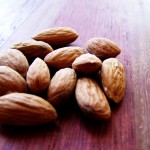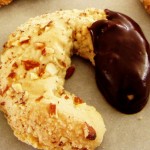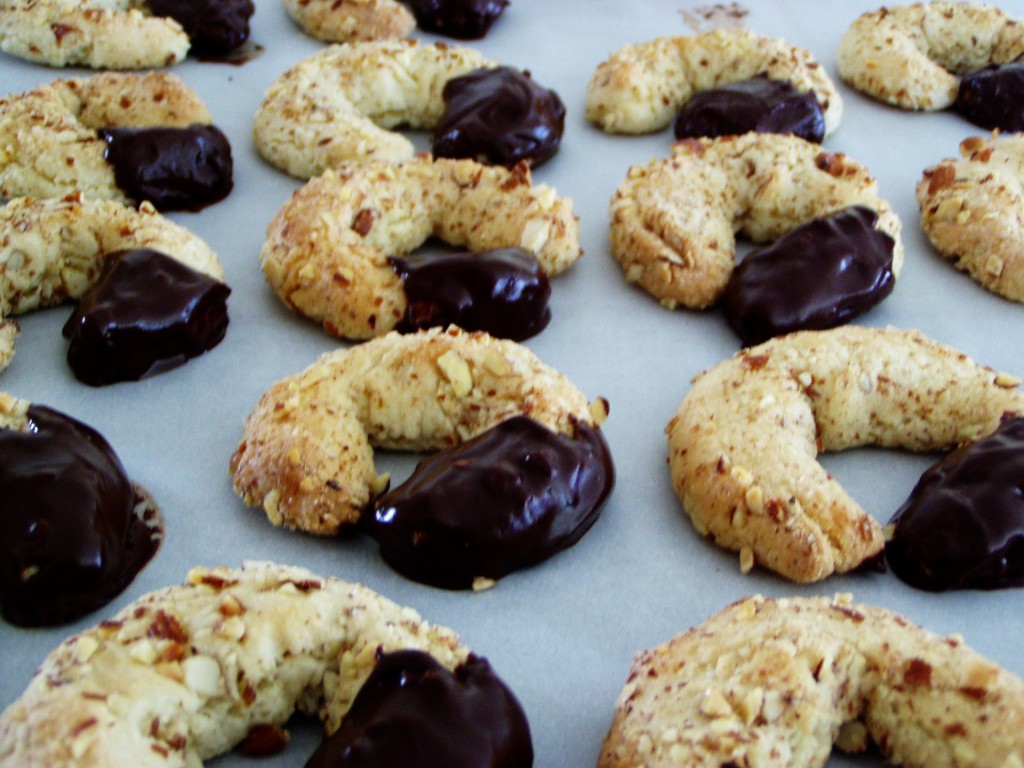Thu 16 Apr 2009
Food for Thought, and Something Good Involving Almonds
Posted by Bria under Baking



Once upon a time, an enterprising member of a hunter-gatherer tribe grew restless at the idea of yet another bowl of the same mammoth stew and added a handful of peppery-smelling leaves to the batch. The first bite brought surprise and delight to all, and soon seasoning the meat was de riguer.
Or something like that. We don’t really need the specifics. Amidst the variety of reasons our most ancient ancestors began seasoning and varying their food is a reason so simple and obvious it generally goes without saying: because it tastes good.
And so it goes today – we continue to think, churn, generate, experiment, augment, and create, create, create beautiful, wonderful, delicious dishes. Cooking is both an art and a science, and is easily accessible at some level on both fronts. But the art side has a special, unique aspect to it. Everyone participates in it, somehow, every day. You don’t have to listen to music, view a play, examine a painting, or read a book every day, but you do have to eat. I think this is why I find cooking so appealing; it’s at the very core of our lives, waiting to be drawn out and caressed.
Yes, there are different strata of cooking and food. There are simple dishes and complicated ones. I can make a complicated sauce using fifteen ingredients, or a baguette using four. “Good” is so subjective, and doesn’t necessarily correlate to expense, difficulty, or complexity. Food: the great equalizer.
It is also very personal. Everyone’s palate is different, sensitive in varying ways. To prepare food for someone is, in a sense, to attempt to really know a very fundamental part of them. And this is one of the reasons I love to cook. It is powerful to fill an empty plate with the symphonic orchestrations of your kitchen’s contents and your own two hands. You begin with nothing, and end up with a serious something. When you cook with someone else in mind, when you reach out and access someone else’s palate and say “I think I know what you’ll like,” you share a part of yourself with them. I gave my bridesmaids a cookbook of my favorite recipes before my wedding. In the introduction, I told them “I consider the kitchen to be the heart of any home; in sharing these recipes with you, I hope to share a piece of my heart as well as my home.”
I continue to connect with the people around me through food (see, e.g., this website). Recently, upon realizing I had forgotten to wish a coworker happy birthday, I told him I would bring him the baked good of his choice the following Monday. He asked for Mandelhoernchen, a favorite cookie from his childhood in Germany. I happily agreed. He told me later, after leaving me what promises to become one of my all-time favorite voicemails, that he didn’t realize when I told him to specify a baked good that I would be making it. I couldn’t imagine doing anything else.
I found these to be delicious and easy. The total duration is rather lengthy, but the actual hands-on time is minimal (you don’t need to mess with them while they dry for three hours in the middle). You can certainly buy almond paste commercially, but I made my own because I found blanched, slivered almonds before I found paste. Whole Foods sells bags of the almonds for cheap.
Almond Paste
1 lb blanched, slivered almonds
3 cups powdered sugar
2 egg whites
Pinch of salt
1 t almond extract
Blitz the almonds in a food processor or blender until they are finely powdered. If using a food processor, you can continue to blend the rest of the ingredients therein, or you can dump into a bowl and mix by hand – I go food processor all the way, but it’s up to you.
Add the sugar and mix until well-combined. Add the egg whites, salt, and almond extract and continue to mix until you have an even, smooth paste.
Mandelhoernchen
Adapted from Gesine’s recipe at Confections of a Master Baker
Makes 2 dozen
1 recipe almond paste (see above) or 1 lb commercially-prepared paste
4 oz granulated sugar
3 egg whites
AP flour
8 oz slivered almonds (I cheat and chop them with a knife because I am lazy)
1 cup sugar
1 cup water
2 cups semi-sweet chocolate chips
Combine almond paste and sugar in a medium bowl with a hand mixer, or in the bowl of a stand mixer fitted with the paddle attachment. Mix until well-combined, about a minute.
Continue mixing as you drizzle in the egg whites. Mix until it all comes together in a uniform, slightly sticky mass.
Cover a workspace with a light dusting of flour. Turn the dough out onto your work surface and divide in two. You will need flour on your hands to prevent the dough from sticking to you (not that you will mind having to lick your fingers, because WOW, this dough is delicious). Roll each half into a 15” log and divide into 12 pieces.
Roll each piece in the chopped almonds, making them into little logs that are between 5 and 6 inches long. Bend them into little horseshoes and place on parchment-lined baking sheets. Allow to dry for approximately three hours.
Bake each sheet at 375 for 15-20 minutes. They should be golden and lovely when they are done. While the first batch is cooking, microwave the water and remaining cup of sugar in a bowl for one minute on high. Brush each horn with this simple syrup as soon as each sheet comes out of the oven.
When the horns are cool, melt the chocolate chips. You can do this in the microwave, carefully, or in a double-boiler on the stove. I don’t have a proper double-boiler; I use a small saucepan of water and set a mixing bowl in it. The idea with chocolate is that it melts with its own radiant heat, i.e. do not set them in the microwave and expect it to turn to liquid before your very eyes. This is the way you set your microwave on fire. I found that out the hard way when I was 9. When chocolate chips are getting in a melty way, they will start to get shiny. Begin stirring, and soon you’ll have your melted chocolate.
Dip the ends of your horns in the chocolate and allow to dry before serving.
767 Responses to “ Food for Thought, and Something Good Involving Almonds ”
Trackbacks & Pingbacks:
-
leyou…
Mandelhoernchen | The Salty Spoon…

кухни на заказ кухни на заказ .
раскрутка сайта по трафику раскрутка сайта по трафику .
кухни спб на заказ kuhni-na-zakaz-4ru .
seo partners seo partners .
I’m not certain the place you’re getting your information, however great topic. I needs to spend some time studying more or working out more. Thanks for great information I used to be on the lookout for this info for my mission.
I am no longer positive where you’re getting your info, however great topic. I must spend some time learning more or understanding more. Thanks for magnificent information I was looking for this information for my mission.
раскрутка сайтов интернет prodvizhenie-sajta-po-trafiku2.ru .
I am not certain the place you’re getting your info, however great topic. I must spend a while finding out much more or understanding more. Thank you for wonderful info I was searching for this info for my mission.
плазменный стерилизатор инструментов plazm-sterilizatory.ru .
плазменные медицинские стерилизаторы плазменные медицинские стерилизаторы .
I am no longer certain the place you’re getting your info, but great topic. I must spend some time learning more or understanding more. Thanks for excellent info I used to be searching for this info for my mission.
кп по продвижению сайта кп по продвижению сайта .
I’m now not positive the place you are getting your information, but good topic. I must spend a while learning much more or understanding more. Thank you for great information I was searching for this info for my mission.
сео центр сео центр .
прямые кухни на заказ от производителя kuhni-na-zakaz-5ru .
I’m no longer sure where you’re getting your information, but great topic. I must spend some time learning much more or figuring out more. Thanks for wonderful information I used to be looking for this info for my mission.